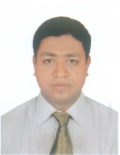Profile of Dr. Mohammad Shahjahan
 |
Name | Dr. Mohammad Shahjahan |
| Designation | Professor | |
| Last Degree | Ph.D. in Condensed Matter Theory (Osaka University, Japan) | |
phy_mjahan.pdf
A Profile CV of Dr. M. Shahjahan Sajid
Job Experience: ▪ Associate Professor, Physics Department, University of Dhaka, Bangladesh
▪ Assistant Professor, Physics Department, University of Dhaka, Bangladesh
▪ Lecturer, Physics Department, University of Dhaka, Bangladesh
▪ Scientific Officer, Bangladesh Atomic Energy Commission
Education:
▪ Ph.D. in Physics (Condensed Matter Theory):
Year of degree : 2013 ; Osaka University, Japan
▪ M.S. in Physics (Thesis Group):
First class (3rd position), Year of degree: 1999
University of Dhaka, Bangladesh
▪ B.S. (Hons.) in Physics:
First class (1st position), Year of degree: 1998
University of Dhaka, Bangladesh
Research Lab:
Condensed Matter Theory (CMT) Lab at CARS (Center for advanced research in sciences), University of Dhaka.
Supervising MS Thesis Research:
Currently 3 students are doing their MS theses research in our group.
Alumni :
8 pupil
Research Field / Project: Ab-initio Materials Simulation(AMS)
Topics / Subjects: 1. First Principles Materials Design Using Electronic Structures Calculation
2. Magnetism & Spintronics Materials
3. Electrical Conductivity Calculation
4. XAS, XES, and Topological Insulator
5. Creation of Innovative Functions of Intelligent Materials on the Basis of Element Strategy
6. H absorption, adatom, and Nanoparticles Calculation.
Calculation Methods:
1. KKR-GF-MT-CPA-GGA
2. FLAPW (GGA+U, SOC)
3. PAW-GW (VASP)
Research Field:
Presently, I use three first-principles electronic structure calculation methods, namely KKR-Green's function, FLAPW (full-potential linear augmented plane wave) and PAW (Projector Augmented Wave) and study dilute magnetic states (DMS), band structures, magnetic properties, enthalpy of formations, and hyperfine fields based on transition metal doped in wide gap chalcopyrite semiconductors. Hydrogen storage energy is calculated with various bulk, surface, and nanoparticle models using the PAW scheme implemented in VASP package. Density functional theory (DFT) is the basic platform of calculations to design real spintronics materials exploited in commercial applications. Previously, I worked on some model pseudopotential calculations of thermal conductivity of metallic glasses at low temperatures. Subsequently, I had calculated surface, static and transport properties of some liquid metals.
Keywords of Research:
Dilute Magnetic States (DMS), Half Metallicity, Chalcopyrites, Coherent Potential Approximation (CPA), KKR-Green’s Function, Muffin Tin (MT) Potential, FLAPW, PAW, Nanoparticles.
Previous Works:
Liquid state properties of some liquid 3d transition metals, namely a study of structural, thermodynamic, atomic & thermal transport and surface properties of liquid and amorphous metals and their binary alloys. So far, we used the well established pseudopotential theories, thermodynamic perturbation method (WCA, LWCA etc.). In the study of thermal transport properties, the two level tunneling model is used. Later, I calculated the atomic transport properties namely the shear viscosity and diffusion coefficient of liquid binary alloys, where we used the statistical theoretical method as proposed by Rice and Allnatt [J. Chem. Phys. 34 (1961) 2144]. To develop an efficient electronic transport theory which describes the electrical resistivity from the view point of different mechanisms ( Normal and Umklapp type) involved in the scattering process is a remaining issue.
Academic Dissertations:
[2] First-Principles Study on Dilute Magnetic States and Half Metallicity in Chalcopyrite Semiconductors -- Ph.D. Thesis, Osaka University, 2013
[1] Studies of Low Temperature Thermal Conductivity in Metallic Glasses Using Two Level Tunneling Model -- M.S. Thesis, University of Dhaka, March 2002
Motto: Integrity and Quality (IQ)
Purpose: 1. Academic Excellence
2. Promotion of Science
Scientific Publications in SCI Journals:
[8]
[7] M.A. Shamsul, M. Shahjahan, and M.M. Rahman, J. Bangladesh Acad. Sci. 41, 217 (2017).
[6] I.M. Razzakul, M. Shahjahan, M. Shamim, and M.M. Rahman, Bangladesh J. Phys. 21, 35 (2017).
[5] M. Shahjahan, I. M. Razzakul, and M. M. Rahman, Computation. Condens. Matter 9, 67 (2016).
[4] M. Shahjahan and T. Oguchi, J. Phys. Chem. Solids. 93, 157 (2016).
[3] M. Shahjahan, M. Toyoda, and T. Oguchi, J. Phys. Soc. Jpn. 83, 094702 (2014).
[2] E.H. Bhuiyan, A.Z.Z. Ahmed, G.M. Bhuiyan, and M. Shahjahan, Physica B 403, 1695 (2008).
[1] G.M. Bhuiyan, M. Shahjahan, I. Ali, and S.M.M. Rahman, Int. J. Mod. Phys. B 17, 2259 (2003).
Selected Presentations in International Meetings:
[5]
[4] The Physical Society of Japan (JPS) 68th Annual (Spring) Meeting: Oral Presentation, March 26 - 29, 2013, Hiroshima University (HU), Japan. KKR-CPA calculation of magnetic half metal based on chalcopyrite semiconductor CuAlSe2 – M. Shahjahan and T. Oguchi
[3] 15th Asian Workshop on First-Principles Electronic Structure Calculations (ASIAN-15): Poster Presentation, November 5 - 7, 2012, Institute of Atomic and Molecular Sciences (IAMS), Academia Sinica, Taipei, Taiwan. Ferromagnetic Half Metals Based on Chalcopyrite Semiconductor CuInS2 –M. Shahjahan, T. Oguchi and K. Shirai
[2] Conference on Computational Physics (CCP2012): Poster Presentation, October 14-18, 2012, (K-computer site) Kobe, Japan. Ferromagnetic half metals based on chalcopyrite semiconductors CuAlSe2 and CuInS2 – Shahjahan M, Oguchi T and Shirai K
[1] International Conference on Magnetism and Advanced Materials (ICMAM-2010), March 3-7, 2010, BUET, Dhaka, Bangladesh, Oral Presentation.
Computer Literacy:
▪ OS: Windows and Linux ▪ Skilled on Accelrys Materials Studio, VESTA
▪ Programming Language: FORTRAN, C
▪ Type Setting Code: Latex ▪ Graphical Program: Gnuplot, Origin, P4Vasp
Memberships: ▪ Bangladesh Physical Society (BPS)
▪ The Physical Society of Japan (JPS)
Language Proficiencies: ▪ Bangla : First Language ▪ English : Excellent proficiency
▪ Arabic & Urdu : Read only ▪ Japanese : Speak only
Countries Visited: Japan, China, India, Taiwan, UAE, Thailand
References:
▪ Prof. Dr. T. Oguchi
Department of Theoretical Nanotechnology, ISIR, Osaka University, Japan
Email: oguchi@sanken.osaka-u.ac.jp
▪ Prof. Dr. K. Kuroki
Department of Physics, Graduate School of Science, Osaka University, Japan
Email: kuroki@phys.sci.osaka-u.ac.jp
▪ Prof. Dr. H. Ebert
Department Chemie, Ludwig Maximillans University, Munich, Germany
Email: Hubert.Ebert@cup.uni-muenchen.de
